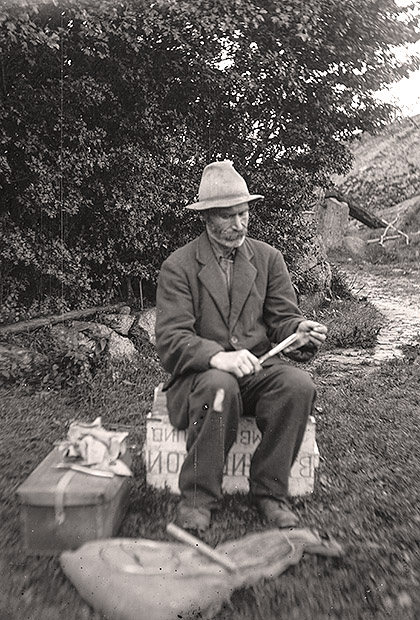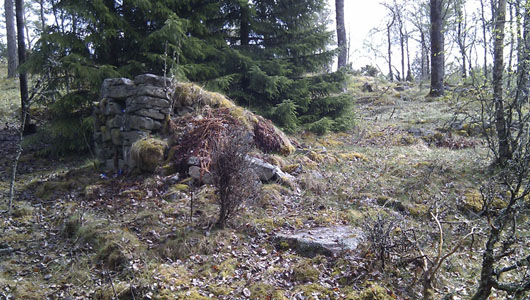Life on the road
For centuries the travellers have lived and supported themselves on the road and this has made mobility important. Many travelled within certain areas by well-worn routes, but sometimes there were longer journeys. To be able to adjust their means of support was essential to survival. Their employment and the roads they travelled could therefore vary from one year to another.

A woman and two children who have spent the night in a barn at Skistad in North Bohuslän around 1920. A note by the photographer tells us that they were travellers. Photo: Johan Johansson. Bohuslän Museum archives.
Meeting of people
On the farms there were copper vessels that became toxic without their protective coating of tin on the inside; knives grew blunt and it was a long way to the shop. Moreover the villagers liked to be amused by stories from other parts. The travellers’ visits to the villages, tin-plating vessels, grinding knives, entertaining, or selling various goods were a welcome little break in the daily routine. Then the travellers could move on.
It was important to find places to stay the night when on the road. A bed of fir branches might do in summer, but in the cold of winter a night’s lodging was needed if it was a long way home or to relatives. It wasn’t always easy, but the travellers knew the farms where they were welcome even if at times it was forbidden to give night accommodation to travellers. But sometimes they got the cold shoulder and had to look go elsewhere.
A woman, born in 1857, from Bullaren in the parish of Mo, recalls in a note for the Western Sweden Institute of Folklore Research. ”I’ve put up many vagrants. You had to put them in the cowshed, the poultry houses or the barn. Sometimes there could be six or seven of them.” … ”The men did the tin-plating, mended leaden vessels, bought horsehair. And they made weavers’ reeds and sold them, or mended old ones. The women begged and told fortunes – it was jöleri!” (Department of Dialectology, Onomastics and Folklore Research, Gothenburg. IFGH 5012:40)

Knife grinder from Nättraby in Blekinge visiting Bohuslän in the early 1900s. Photo: Johan Johansson. Bohuslän Museum archives.
Life at Mon
Augusta and Karl-Albin and their children lived at Mon, a few kilometres from Snarsmon in Bullaren in North Bohuslän, from the 1880s until 1913. Their house stood beside the main road, just east of the notorious steep hill of Ejde Bratta on what was then a stretch of Route 164. The house was a little crofter’s cottage with one room and a small patch of land. Around the croft there were also some simple homes, sometimes occupied by the family’s relatives. The family lived at Mon for over 20 years and most of the children grew up here. There is no reliable information about how many children the family had; different sources say eleven, thirteen or even nineteen children. A neighbour recalled to his grandchild that heads stuck up all over the place in the cottage when he called in the morning. No doubt several of the children went to school, presumably with the children from the travellers’ encampment at Snarsmon, not far away. Augusta and Karl-Albin supported the family with handicraft and trade, like most other travellers. Karl-Albin was a skilful silversmith and metalworker who also made juniper baskets and the like.

Remnants of a stove wall and sill stones from the family’s little house on Mon. Photo: Kristina Lindholm, Bohuslän Museum 2011.
The traveller community
Travellers have lived in Sweden for many hundreds of years, travelling from village to village offering their wares and services. In Sweden, modern-day swedish travellers form part of the Roma national minority. Bohusläns Museum has been working together with members of the traveller community since 2004 to raise awareness of the history of the traveller community as a part of our shared heritage.

![brosch_2_kant[2]](http://www.bohuslansmuseum.se/en/wp-content/uploads/sites/2/2015/12/brosch_2_kant2.jpg)